Project
sets cost of California Native Grassland Restoration at $225,000
per acre!
Photos and text by Craig Dremann, The Reveg Edge, Box
361,
Redwood City, CA 94064 - (650) 325-7333
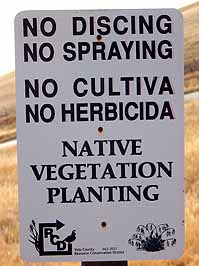 The history of the UC Davis/Caltrans grant project
shown on this website, starting on Feb. 11, 2003, in Yolo County
at the I-505, Road 14 exit test plot site in the Sacramento Valley,
California:
The history of the UC Davis/Caltrans grant project
shown on this website, starting on Feb. 11, 2003, in Yolo County
at the I-505, Road 14 exit test plot site in the Sacramento Valley,
California:
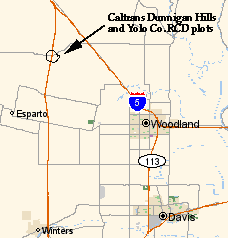
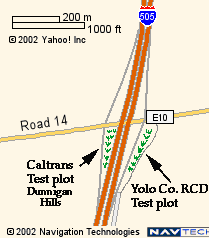
(Just across the Interstate, there's a second native plant
test plot, planted by the Yolo County RCD, see below).
First attempt, a couple of acres drill-seeded with
several species of native grasses, seedlings are 2 inches tall,
Feb. 11, 2003.
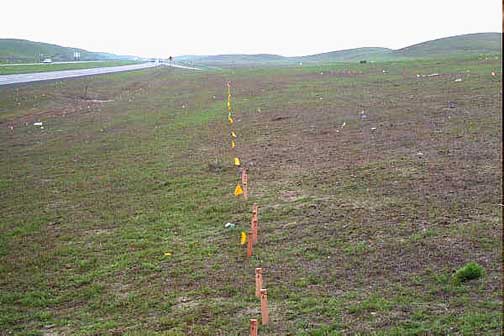
Above: First attempt of Dunnigan Hills Caltrans test plot,
looking south, February 11, 2003.
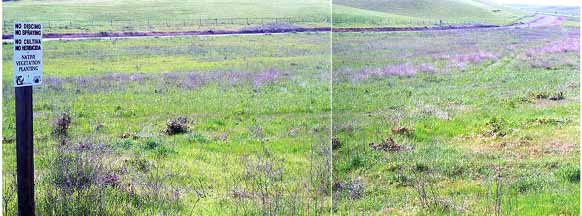
Above: The Yolo County RCD test plot, Dunnigan Hills, across
I-505 from the Caltrans plot, March, 2003.
Some of the hummocks in background are the exotic perennial
grasses. Checking the area in September 2004, there was
a stand of about 50% cover of the native perennial grass Stipa
(Purple Needlegrass).
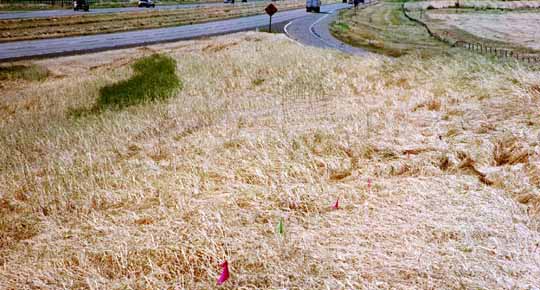
First failure, Dunnigan Hills UC Davis/Caltrans site,
June 2003. This first-year's planting was declared a failure
and the site was sprayed in May and a second attempt planned for
autumn 2003
...What is all that brown stuff?
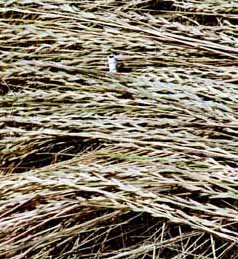
Lodged polyploid ryegrass, six inches deep!
This is one of the aggressive pasture-types developed
in Oregon, now showing up here in California as weeds.
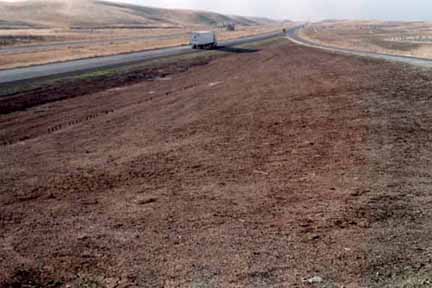
Above: October, 2003, with the Dunnigan Hills site burned
and ready to reseed to try again.
SECOND TRY: January 18, 2004: Photos
below show the Dunnigan Hills test plot second attempt underway.
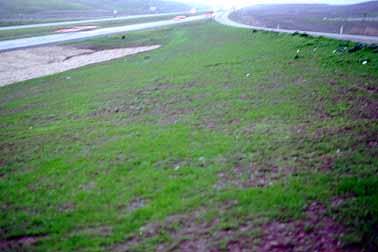
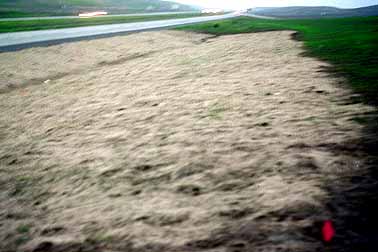
January 2004, part of the site had been recently mulched with
a light covering of native needlegrass straw (Stipa or
Stipa). The exotic grasses have been managed over the whole
two acres, but what is left is a lot of bare soil that's eroding,
plus seedlings of broadleaf weeds: mostly filaree, mustard, dock,
milk thistle, and vetch. Yellow star thistle seedling not observed
yet, but they don't usually show until later in spring.
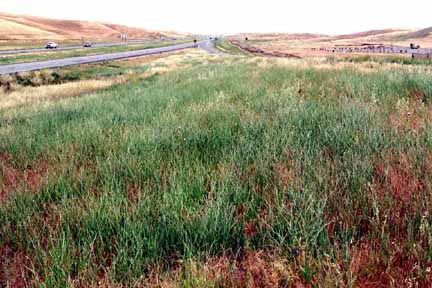
Second failure...Oh, no!...May 2004, the upper portion
not resown...is solid yellow star thistle!
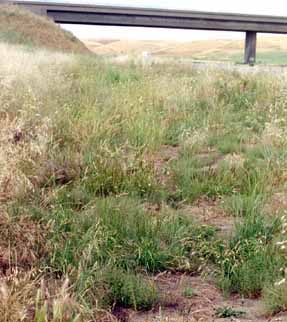
However, in May, 2004, the Dunnigan Hills site did have about
1,000 plants of various native grasses.
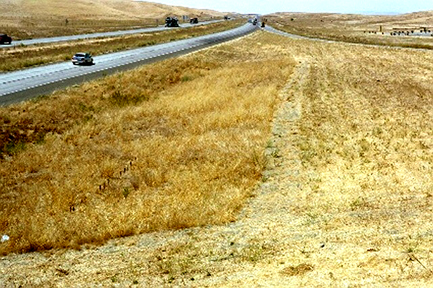 AUGUST, 20, 2004. The upper portions of the Dunnigan
site formerly covered with yellow starthistle was mowed earlier
in the summer. Wild oats encroaching, plus some very robust "Blando"
brome into the former native grass test plot area.
AUGUST, 20, 2004. The upper portions of the Dunnigan
site formerly covered with yellow starthistle was mowed earlier
in the summer. Wild oats encroaching, plus some very robust "Blando"
brome into the former native grass test plot area.
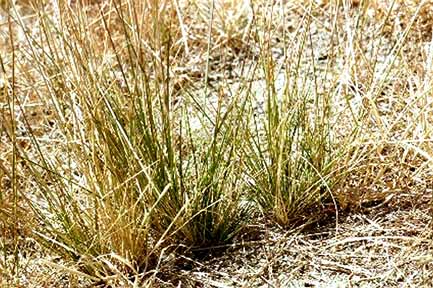 The test plots of various species of California
native grasses are still standing in August 2004, but may not
survive though the winter of 2004/2005.
The test plots of various species of California
native grasses are still standing in August 2004, but may not
survive though the winter of 2004/2005.
September 9, 2005:
A total of only four native grass plants appears to have survived
in the whole Dunnigan Hills test plot site, and the area was recently
mowed.
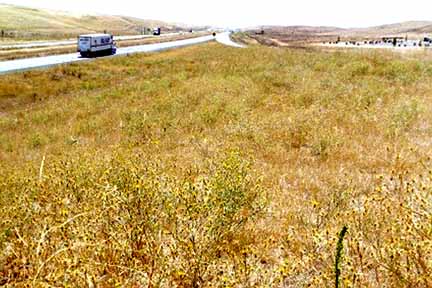
Former upper test plot area.
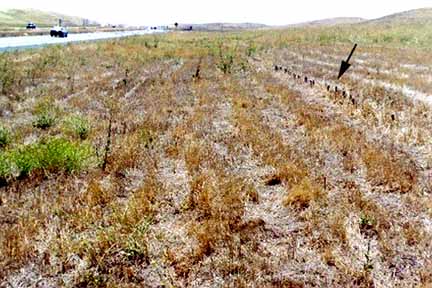
Test plot area, arrow is where the line of wooden stakes is located.
Third replanting attempt, July 12, 2006 -
Another replanting attempt, unfortunately failing:
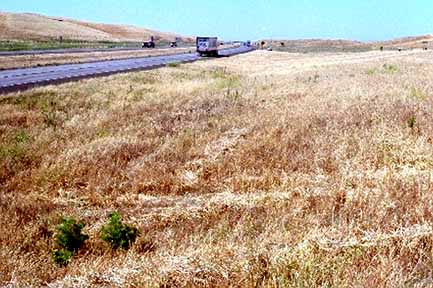
Between September 2005 and spring 2006, the test plot was plowed
and resown by drill-seeding with Elymus glaucus and some four-inch
tall Purple Needlegrass, that is barely surviving as an understory
beneath the weeds. This test plot has been treated like an annual
flower-bed, resown every year and hoping for the best. No ecological
restoration technologies have been used or successful techniques
invented on-site, that would guarantee plant survival and establishment.
Plants seen in the photo are exotics, with the 4%
native grass cover underneath the weed canopy. By September
2006, this whole area was mowed to about 3 inches tall, and you
could clearly see about 1% Purple Needlegrass cover still surviving.
That means for 2 acres, only about 1,000 sq. feet total of native
grass cover survived.
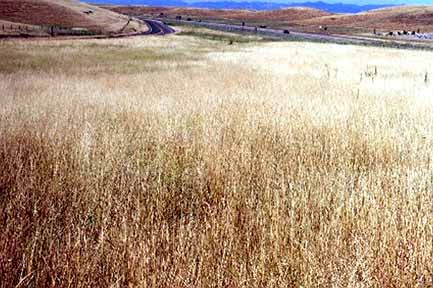
Fourth planting attempt, spring 2006, UC Davis took over
the Yolo County RCD test plot area, and it was plowed and replanted,
by drill seeding on 8 inch-centers, mostly Purple Needlegrass
and some Elymus glaucus, which has formed a nearly solid stand
by July 2006. Each plant is growing on 4-8" centers within
the drill-row. However, in the distance you can see scattered
wild lettuce and mustard plants, and even at these very low amounts,
could eventually start the domino-like collapse of this nice planting.
Along the mowed roadside edge of this planting at
this time, is a solid 80% yellow star thistle, 10% mustard, 5%
ryegrass and 5% wild lettuce cover, just waiting to invade.
Planting only two species of grasses does not necessarily recreate
a self-sustaining California grassland ecosystem . Scattered within
the planting are these same weeds, plus a understory carpet of
the vine, bindweed.
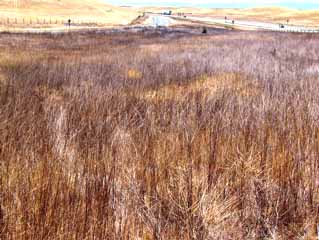
August, 2007, planting is still intact.
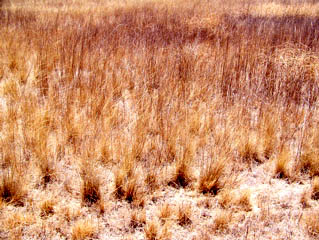
Notice the wide spaces, without other species of native plants
between the native bunchgrass plants. "Vacancies"
in the planting can allowing weeds to colonize. Islands
of weeds, once they get established, like patches of mustard,
can unravel the planting from within. Or star thistle can move
into the bare spaces, like a wave, from the edge.
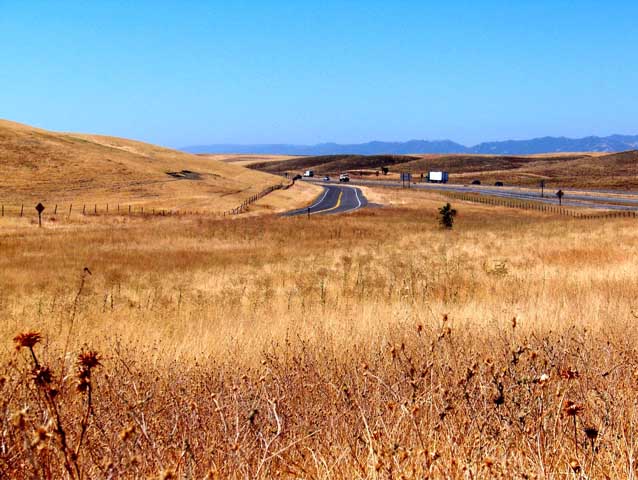
August, 2008...Oh, no, what's all that spiny stuff invading
the native grassland? Mostly yellow star thistle coming in
from the edges! The green in the center, is the wild lettuce starting
the destruction of the planting from within. About 10% of the
planting is already solidly infested, and will probably last another
ten years under drought conditions, or 2-4 years with normal rainfall.
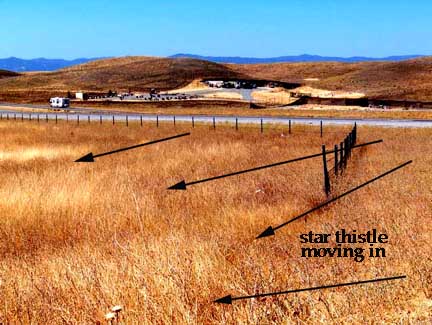
Update, August 2009:
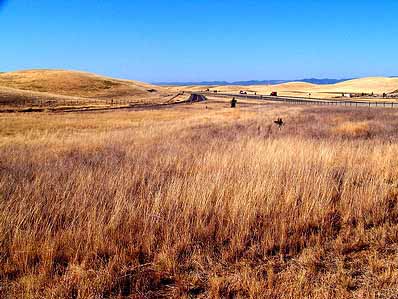
Wild oats still invading from the left, and the star thistle
and mustards from the right.
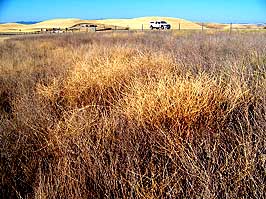
Solid star thistle, and star thistle plus mustard
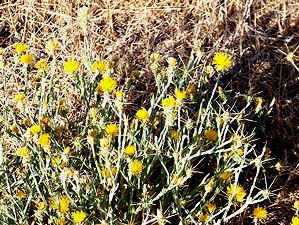
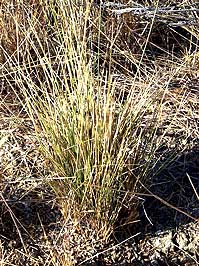
Star Thistle (left) plus Stipa native grass (right) in the
east side test plot, when unmolested by the weeds. All of the
Elymus glaucus plants have died.
FIFTH PLANTING ATTEMPT. The west side plot was resurrected
by a professor at UC Davis, and replanted in autumn 2008 with
a drill seeder. Then, the plot mowed in late 2009 and late
spring 2010. Only 15 pounds per acre of Stipa cernua, which produced
only about 30% coverage. Photos August 23, 2009
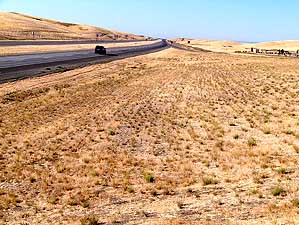

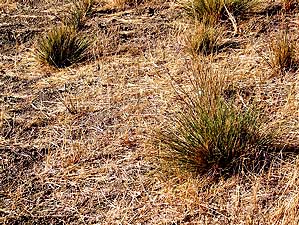
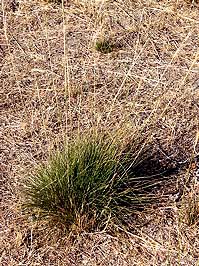 Notice the big gap between plants, with nothing
native in between to fill in the spaces. The big gaps are equal
to putting out a huge vacancy sign, with lots of room for weeds
to move into.
Notice the big gap between plants, with nothing
native in between to fill in the spaces. The big gaps are equal
to putting out a huge vacancy sign, with lots of room for weeds
to move into.
Update August 2010
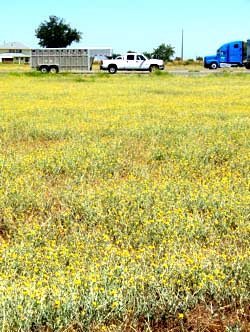
What a typical I-5 or I-505 interchange, how it looks in August,
solid yellow star thistle
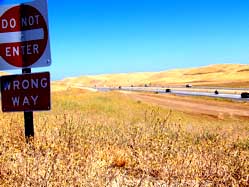
Dunnigan Hills test plot site, NW corner where nothing has
been planted yet, solid yellow star thistle.
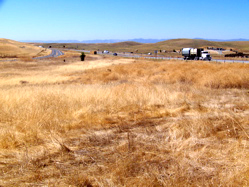
East side site, mustards moving in from the west.
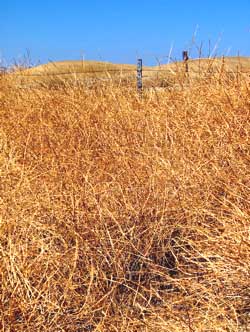
Mustards moving in on east side plot.
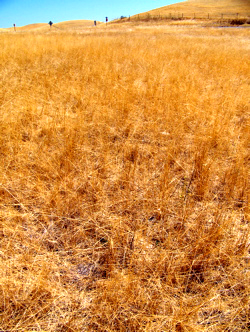
The unmolested Stipa grasslands.
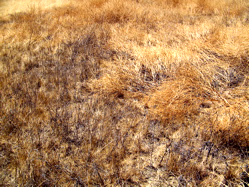
The edge of the mustards, eating the Stipas for lunch, like a
giant amoeba.
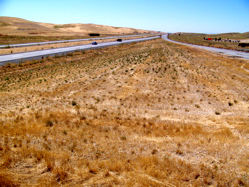
West side plot, with about 30% Stipa cover, mowed in early
spring.
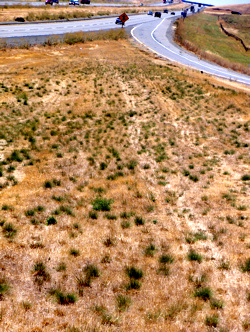
Stipa cover on west side plot.
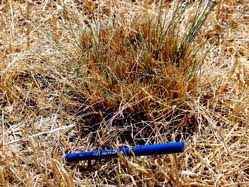
Mowed Stipa, too close, regrowing.
What was done in the fifth resowing
in the west side plot,
which may cause future failure:
(1.) The plot was drill seeded on 8-inch centers
instead of broadcast-sown.
(2.) The sowing rate of the Stipa grass was drilled
at only 15 pounds to the acre, or only about 1/5th of the rate
per acre needed to get good cover on the site, and,
(3.) Only one native species of grass survived,
and no other natives were sown to fill the niche of the broadleaf
weeds, like anything from the sunflower family to take the place
of the yellow star thistle, for example. No legume family, no
Indian paintbrush family, no milkweed family, etc.
Update August 2011 - Are we ever going to see solid
native cover on these test plots?
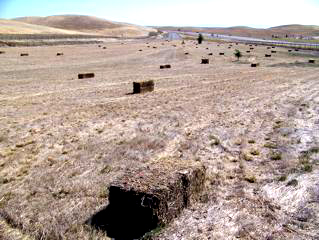
East side plot baled, probably to manage the weeds. Star thistle
plants mixed in the bales--what you can do with these bales except
compost them? A 100-pace toe-point transect only produced 26%
native grass cover, 3% mustard and the rest were annual weeds.
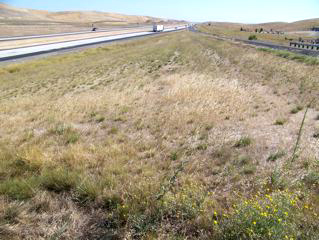
West side looking OK, with yellow star thistle moving in from
the north, and measuring a 100-pace toe-point transect, 46% Stipa
cover, 2% Elymus glaucus, 32% annual grasses, 15% wild oats, and
5% yellow star thistle.
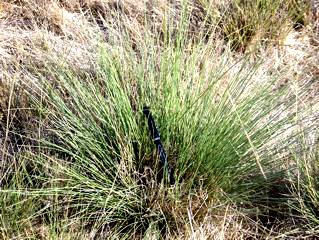
Old plants of Stipa on the west side, 5-8 inches in diameter
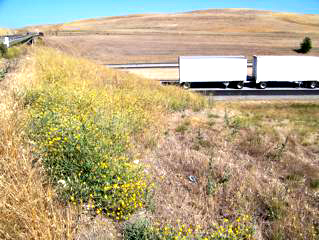
Oh, no...what is that infestation of yellow star thistle, coming
in from the north?
UPDATE JANUARY 2012
The west and east side project have both stabilized at exactly
the same amount of native plant cover, all Stipa pulchra, at 28%,
with 72% weed cover.
UPDATE May 2012
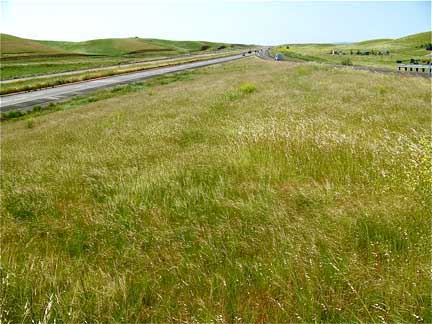
West side plot
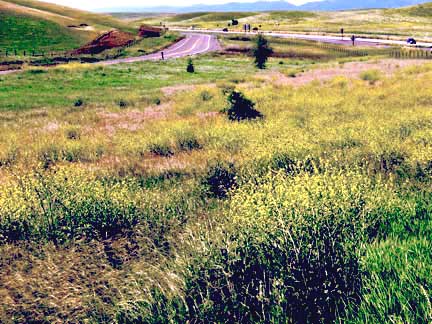
East side plot, mustards coming in thick, as predicted.
Little or no rainfall in January and February, has severely knocked
back the annual grass weed seedlings, so the perennial native
Stipa has been given an advantage and in the West plot has increased
to 38% cover, and also 2% of native lupine is now showing up,
probably from dormant seeds that were in the soil underneath the
weeds. The remaining 60% weed cover on the West side is a 20%
cover of wild oats, 8% red brome, 6% Blando brome, and 2% cover
each of yellow star thistle, and bindweed.
The 38%-46% perennial native grass cover is probably
the maximum cover for the grasses, and now the remaining 60% that
is weeds, needs to be converted to the other native grassland
plant families, like the sunflower family, and the poppy family,
etc.
If we look at this project and calculate how much
it cost for every percentage of native cover, that means that
it cost about $6,447 for every one percentage of native cover
that was produced. Therefore, to get 100% cover at that rate,
would ultimately cost $650,000 per acre.
Update July 2013
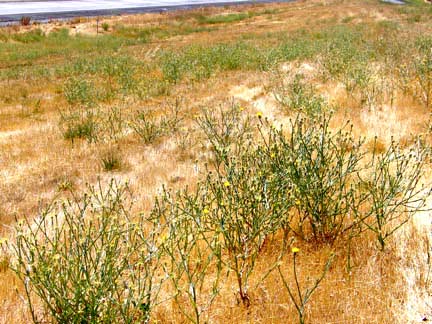
West side plot getting star thistle infested again. The West
side was mowed to about two inches tall, and was 34% weeds, 62%
Stipa and 4% yellow star thistle. The East side plot was not mowed,
and was 72% weeds and 28% Stipa. Medua head grass and tumbleweeds
present in East side plot.
Updated August 26, 2014
EAST SIDE: Finally Stipa is now 85% cover, mostly
due to the exceptional drought knocking back the weeds, and the
weed grasses are now down to 15%, mostly wild oats, medusahead
and weedy Bromes. This side not mowed.
WEST SIDE: Mowed to 3 inches tall, Stipa 36% cover,
weed grasses 64% cover. Mowing during the drought seems to knock
back the native grasses, rather than help them, and the Stipa
cover has shifted significantly downward.
Update August 21, 2015
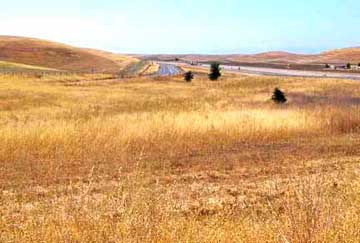 EAST SIDE: Weeds coming back in between the Stipa,
mostly red brome, due to the lack of wildflowers and non-grass
natives, with the exception of the amsinckia making its first
appearance. 56% Stipa and 4% Amsinckia for the natives. Exotics
were 22% Red Brome, 10% yellow star thistle,
EAST SIDE: Weeds coming back in between the Stipa,
mostly red brome, due to the lack of wildflowers and non-grass
natives, with the exception of the amsinckia making its first
appearance. 56% Stipa and 4% Amsinckia for the natives. Exotics
were 22% Red Brome, 10% yellow star thistle,
4% Italian thistle, 2% wild oats, and 2% rose clover.
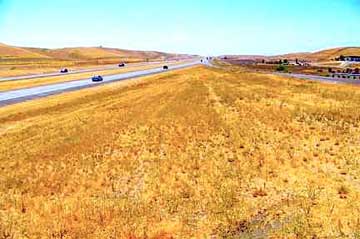
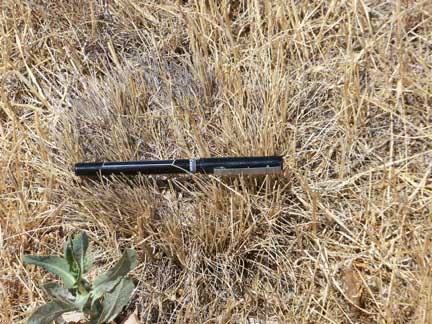 WEST SIDE: Mowed to 3 inches tall, Stipa cover increased
to 62% but yellow star thistle now 36% and wild lettuce 2%. Some
of the mowed Stipa plants are quite large, up to 8 inches across
now. No medusahead or weedy bromes seed. Big empty spaces between
Stipa plants allow the weeds to get a toe-hold.
WEST SIDE: Mowed to 3 inches tall, Stipa cover increased
to 62% but yellow star thistle now 36% and wild lettuce 2%. Some
of the mowed Stipa plants are quite large, up to 8 inches across
now. No medusahead or weedy bromes seed. Big empty spaces between
Stipa plants allow the weeds to get a toe-hold.
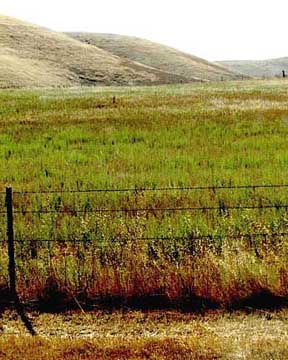 Native tarweed a few miles north, August 2015.
Native tarweed a few miles north, August 2015.
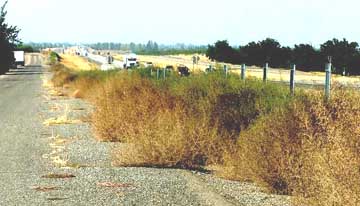 Exotic Stinkwort along I-5 near the town of Dunnigan
ON THE HORIZON, BATTLE between SUNFLOWER FAMILY
MEMBERS.
Exotic Stinkwort along I-5 near the town of Dunnigan
ON THE HORIZON, BATTLE between SUNFLOWER FAMILY
MEMBERS.
On the horizon just a few miles north of this site, are two members
of the sunflower family, whose members will fight a battle for
control of this site in the future. The native hayfield tarweed
vs. the exotic Stinkwort. It will be very interesting who will
win.
Update August 23, 2017
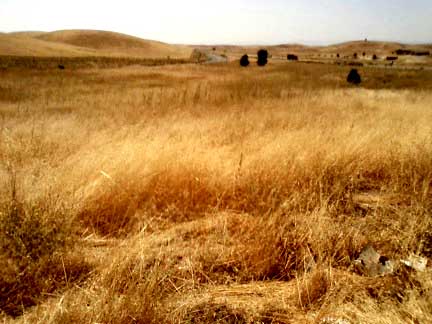 East Side test plot, what a mess, now 78% weed cover,
with wild oats, 8 foot tall wild lettuce and medusahead grass,
and 22% cover of Stipa plants.
East Side test plot, what a mess, now 78% weed cover,
with wild oats, 8 foot tall wild lettuce and medusahead grass,
and 22% cover of Stipa plants.
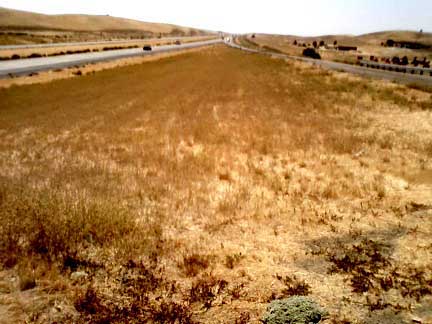
West side test plot, even worse than the East side, with 92% weed
cover mostly yellow star thistle, and only 8% Stipa cover.
Update April 22, 2018
After 16 years, I guess miracles can happen, in
the East side plot!
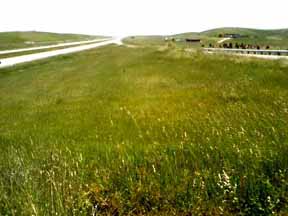 The West side test plot was mowed too short, so
the Stipa plants have suffered, only left with 6% Stipa cover,
plus 60% wild oats, 28% rose clover, 4% yellow star thistle. A
surprise was 4% native lupine.
The West side test plot was mowed too short, so
the Stipa plants have suffered, only left with 6% Stipa cover,
plus 60% wild oats, 28% rose clover, 4% yellow star thistle. A
surprise was 4% native lupine.
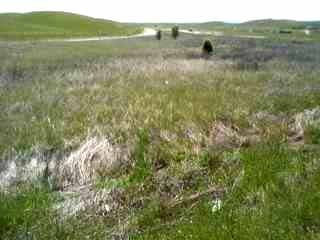
The real surpirse, was once you got away from the mowed roadside,
the unmowed Stipa was producing 84% cover, with only 12% wild
oats, 2% yellow star thistle and 2% mustard! The lack of rainfall
all December then all February may have given an advantage to
the Stipa, plus not mowing.
|
Year |
West Side % natives |
East Side
% natives |
|
2011 |
46 |
26 |
|
2012 |
38 |
28 |
|
2013 |
62 |
28 |
|
2014 |
36 |
85 |
|
2015 |
62 |
60 |
|
2016 |
N/M |
N/M |
|
2017 |
8 |
22 |
|
2018 |
84 |
6 |
|
2019 |
|
|
|
2020 |
|
|
|
2021 |
|
|
N/M = Not Measured
CONCLUSION: UC Davis Project
Sets the Price of replanting a California Grassland habitat
The results of the UC Davis project, funded by Caltrans, has set
the price of replanting a low-elevation non-riparian native California
grassland from scratch, after many years of attempts.
UC Davis tried to get two acres of California native
grasslands established from scratch, but without using
any licensed native grassland restoration processes nor inventing
or using any successful licensed ecological restoration technologies.
Instead the project used the currently available public-domain
restoration technologies.
Using public domain technologies, and possibly
adaptive management techniques, the costs planting a low-elevation,
non-riparian grassland in California has been effectively set
by the results of this project at $245,000 per acre, taking over
a decade to produce 60-85% native cover.
The results of this study may have significant impacts
on grassland mitigation projects around the State that are
being currently conducted by CALFED, the U.S. Bureau
of Reclamation and other agencies, The Nature Conservancy
in managing land that they own (TNC), and the various Habitat
Conservation Plans (HCPs) and other permits and Section
7 mitigations around California that require native grassland
restoration.
If the best agricultural university in California
cannot permanently repair an arid ecosystem like a native Western
grassland for less than $200,000 per acre, why should
developers, grazing permittees, pipline companies, or miners be
allowed to destroy any more native grasslands, until we have the
scientific knowledge on how to restore them at a reasonable cost?
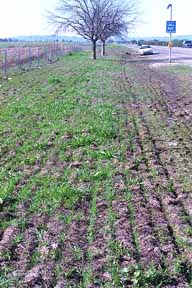
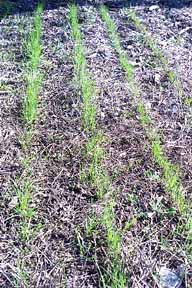
Another series of first-attempt plots, along I-80:
A second Caltrans native grass test plot is along I-80 near
Dixon, photographed March, 2003., both sides of the Interstate
in the shoulder. Photos show native grasses, drill-seeded and
a few inches tall.
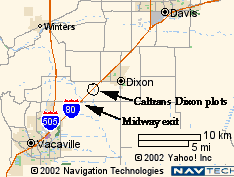
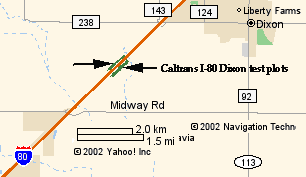
These I-80 test plots were half-way between Midway Road exit
and the Dixon West "A" Street exit.If you are traveling
eastbound from Vacaville, the plot was 1.3 miles past the
Midway Road exit, after where the high power line crosses, and
before you get to a line of trees and the Phone Call box 80-342.
Traveling Westbound from Sacramento, past the Dixon exit,
the test plot started at the Vacaville/Fairfield/San Francisco
mileage sign and Call box 80-343 (PM 34.00) and went toward where
the high power lines cross the Interstate.
By October 2003, these I-80 plots were abandoned.
Checking either side of I-80, there was little or no survival
of the native grasses, and there was no evidence that another
attempt was going to be made to succeed here.
This $90,000 per year, 5-year grant is Caltrans second major
contract in the agency's history to study the conversion of
roadside exotics back to local native plants. Details of the
grant can be seen at HERE
Other links:
---See what questions need answers before native plants for roadsides
can begin: https://www.ecoseeds.com/questions.html
---See a checklist of ten items to get faster successes:
https://www.ecoseeds.com/talk.html
Other Caltrans Roadside
Vegetation Programs:
Adopt-A-Highway "WILDFLOWER PLANTING"
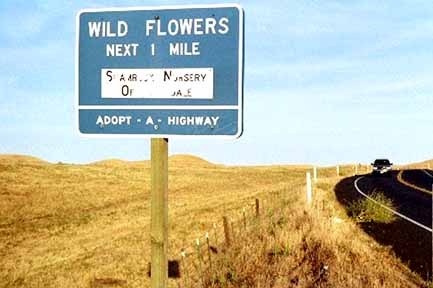 Photo
June 2004.
Photo
June 2004.
Caltrans has an "Adopt-A-Highway Program", and
each of the 12 Districts have District Coordinators, plus a printed
handbook---Chapter ten is "Wildflower Planting".
Participants of the Wildflower program agree to plant wildflowers
on a minimum of three acres of highway right-of-way and establish
them for a minimum of two years. "Wildflower courtesy
signs" are placed by Caltrans with the name of the company
or group involved in the planting.
The "Wildflower Planting" program's desired result?
Perhaps that Caltrans hoped for when the program was initiated,
was adoptees might develop at no cost to Caltrans successful "wildflower"
roadside vegetation with low maintenance costs, better than the
flammable annual exotic grasses and exotic weeds normally along
California's roadsides?
Unfortunately, none of the California native "Wildflower
Plantings" over the last decade, seem to be successful,
and driving up and down the State you will see numerous "Wildflower"
signs, with no fields of California native wildflowers at the
various sites. The program has resulted in providing cheap advertising
for companies, without the companies having to pay the minimum
of $200,000-500,000 per acre that a successful wildflower planting
in California could cost, as the UC Davis project has established.
Caltrans' "Wildflower Planting"
program should be discontinued state-wide,
until the costs of successfully establishing a wildflower planting
drops into a price per acre that civic groups or commercial businesses
can actually afford.
Updated December 24, 2022 - The Reveg
Edge Ecological Restoration service



















Photo
June 2004.